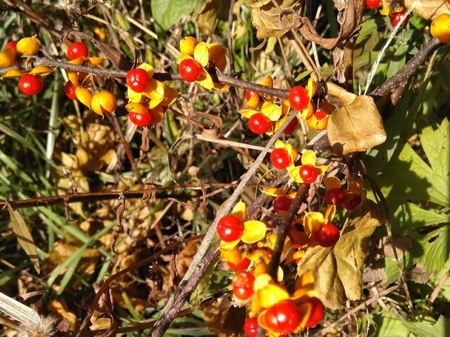
Good Natured: Oriental Bittersweet
If you’ve been a Good Natured reader for any length of time, you’ve likely noticed that wildlife columns outnumber plant columns by at least two to one. With good reason.
I’m just not very good with plants.
Sure, I can point out our more notable natives, and I can lament non-native buckthorn, honeysuckle, and garlic mustard ’til the cows come home. But for the most part, I feel better leaving the commentary on our local flora to bona fide botanists and gardening enthusiasts.
However, every once in a while, a plant-related issue pops up that even I can’t ignore. Sometimes the topic is timely, sometimes it’s controversial. This week, though, it’s bittersweet.
Oriental bittersweet, that is: Celastrus orbiculatus.
Also known as Asiatic bittersweet and round-leaf bittersweet, this introduced vine with colorful berries is a common component in holiday floral arrangements. Brought to our country around 1860 as an ornamental as well as for use in erosion control, it now can be found across much of eastern North America and is quite at home here in northern Illinois. Like a distant relative who came for Thanksgiving dinner and now is camped out on your sofa, Oriental bittersweet is a guest that will not leave.
Although it resembles its native counterpart American bittersweet, C. scandens, Oriental bittersweet differs in many subtle but significant ways. For one, its berries grow from the leaf axils of the vine and are strung out along the stems; the fruit of American bittersweet, by contrast, grows only at the ends of its branches. (Easy ways to remember these differences, courtesy of the Minnesota Department of Agriculture and UMN Extension: “Strung out is bad,” and “Save the best for last.”)
Further, Oriental bittersweet fruit is surrounded by yellow seed capsules that pop open when ripe, while American bittersweet capsules are orange. (Another memory-helper: “Yell when you see Yellow; Orange is Okay.”)
But probably the biggest differences between these two vines are their growing habits. American bittersweet grows vigorously yet behaves. It doesn’t blanket its surrounding landscape and smother everything in sight.
Oriental bittersweet, by contrast, has the capacity to strangle practically every tree and shrub it encounters. Its twisting vines can reach more than 60 feet in length, with additional shoots popping up as the roots spread. Allowed to grow unchecked, the plant can engulf a woodland canopy and shade out the trees and herbaceous plants below. What’s more, its weight, when accompanied by winter’s snow and ice, can cause branches to break and trunks to snap.
It’s a reckless beast, for sure. And why shouldn’t it be? It’s found everything it could possibly need to survive and thrive here in its home away from home. It’s not fussy about soils, and while it prefers full sun, its seeds can grow in dense shade. It can be found in dense woods, open woods, woodland edges, grasslands, fence rows, and—good gravy—even sand dunes and beaches.
While its vines are problematic, Oriental bittersweet’s flowers and fruits are what drive its ever-expanding success. When growing near one another, this invader’s male flowers often fertilize the female flowers of American bittersweet, thwarting the native’s ability to reproduce. Further, the prodigious quantities of fruit produced by Oriental bittersweet are gobbled up by birds like robins, bluebirds, and catbirds. Their digestive systems process the flesh but expel the seeds and voilà! New vines start to grow.
Besides wildlife, humans also have aided Oriental bittersweet’s spread, as so many of us have purchased and transported the plants hither and yon. Even though several states now regulate the selling of Oriental bittersweet (Illinois banned its sale in 2015), it’s not hard to find seeds for purchase online.
Perhaps more distressing is the finding that some plants being sold as American bittersweet actually are not. In 2017, Illinois Natural History Survey plant ecologist David Zaya and his colleagues published research showing that seven of 11 vendors in Nebraska, Missouri, Indiana, and, yes, Illinois, were selling plants tagged as American bittersweet but in fact were the Oriental species.
Ugh.
This time of year, lots of folks are decking their halls, not just with boughs of holly but also with vines of bittersweet. Before you hang that wreath or garland with the abundant colorful berries, do yourself, your neighbors, and your environment a big favor and double-check your “decks.”
If your arrangement contains fruits even remotely resembling those in the accompanying photo, please don’t hang it outside. More than a few of those berries are sure to drop into the soil, where a new vine will then result.
Use care when dismantling your decorations too. When it’s time for the trimmings to come down, be sure to bag all the bittersweet and tie it up tight before tossing it in the trash. Don’t gamble that its seeds won’t survive in a compost bin; they’re tough and likely will persist until the next growing season.
Burning the vines might be an even better disposal option, provided you watch to ensure every last berry is incinerated. They were pretty, for sure, but they need to become a bittersweet memory.
Pam Otto is the outreach ambassador for the St. Charles Park District. She can be reached at potto@stcparks.org.

